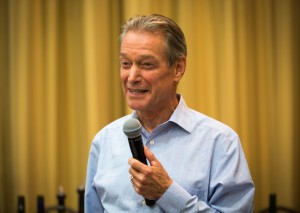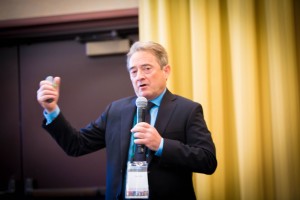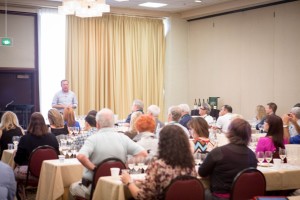We had a wonderful time at the 41st Annual Conference of the Society of Wine Educators, held August 10-12, 2016 at the lovely Red Lion Hotel on the River, located on the Columbia River in Portland, Oregon!
Below you will find some pictures, presentations, and handouts provided by our wonderful speakers—the next best thing to being there!
The Crystalline Beauty of Riesling: A Comparison of Global Styles—presented by Roger Bohmrich, MW: On Saturday afternoon, Roger Bohmrich, MW presented a comprehensive class of Riesling. The session began with a discussion of the characteristics of the Riesling vine and its suitability to various climates. Next, the class focused on the wines themselves: highly aromatic, highly acidic, sometimes dry and sometimes with a bit of RS, but almost never blended with other grapes.
As an introduction to the tasting portion of the class, Roger presented a taxonomy of Riesling styles—ranging from cool climate”just ripe” wines through intermediate and warm climates all the way up through ice wines and wines produced with botrytis-affected grapes. The tasting portion of the session began with New World Riesling, and included wines from Australia (Eden Valley and Clare Valley), Oregon (Willamette Valley), Washington State (Columbia Valley), Canada (Ontario’s Niagara Peninsula) and New York State (Finger Lakes).
The next portion of the tasting featured the benchmark Rieslings from the Old World. This tasting included wines from Germany (the Mosel, Rheingau, and Rheinhessen regions), Austria (the Wachau and Kamptal areas), and France (Alsace). For details of the wines and the slides of Rogerâ’s session, click here: The Crystalline Beauty of Riesling-Bohmrich-SWE 2017
Way Beyond Bubbles: Terroir, Tradition and Technique in Conegliano Valdobbiadene Prosecco DOCG—presented by Alan Tardi: On Saturday morning, Alan Tardi told the story of the modern history of Prosecco, from 1876 when enologist Giovanni Battista Cerletti founded the Scuola Enologico in Conegliano, through the 1948 creation of the Bellini cocktail (Prosecco and fresh peach nectar) at Harry’s Bar in Venice, and all the way to the creation of the Conegliano Valdobbiadene Prosecco DOCG in 2009.
The session continued with in-depth discussion of the climate, soils, and topography of some of the more specific Prosecco-producing areas such as Conegliano, the Rive di Farra di Soligo (in Valdobbiadene), and the Cartizze Sub-zone. The tasting included many interesting styles of Prosecco, including tranquile (non-sparkling), those using a percentage of indigenous grape varieties, several single-vineyard wines, and wines that underwent the second fermentation in the bottle (including one bottled “col fondo” [without disgorgement]). For more details, see the presentation here: Prosecco-Way Beyond Bubbles-Presented by Alan Tardi
Taking Root: The Renaissance of Chardonnay in Oregon’s Willamette Valley—presented by Sam Schmitt, CS, CSS, CWE: On Friday morning, Sam Schmitt, CS, CSS, CWE, told the story of Chardonnay in Oregon’s Willamette Valley. The class began with a discussion of the geologic history of Oregon and the formation of the soils—marine sediment, volcanic basalt, Missoula alluvial, and windblown loess—for which the area is now known.
The class then focused on the history of Chardonnay in Oregon, and revealed on surprising note: that the narrative that early Willamette Chardonnay was a failure is a great over generalization and exaggeration. Rather, the truth is that Chardonnay in Oregon experienced a long learning curve to determine what viticultural and winemaking procedures worked best for the grape in Oregon—similar to the process for “perfecting” the “Oregon style” of Pinot Noir and Pinot Gris. The truth is, many early examples of Oregon Chardonnay were excellent.
The wines improved overall over the decades as many different clones and selections of the Chardonnay grape were planted. Some of these hailed from France, others from UC Davis, and many were promulgated by the founders of the Oregon wine industry, from David Lett to Bethel Heights. For more details on the session, as well as the wines included in the tasting, see the presentation here: Taking Root – Chardonnay in the Willamette Valley-presented by Sam Schmitt
We will be posting many more conference recaps in the days to come, and will create a permanent record of them here.


